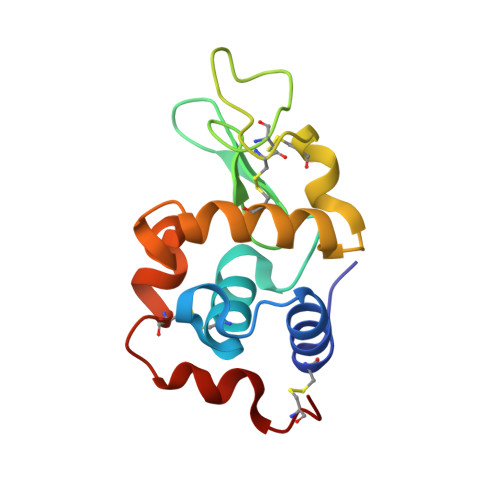X-ray structural analysis of the ligand-recognition mechanism in the dual-affinity labeling of c-type lysozyme with 2',3'-epoxypropyl beta-glycoside of N-acetyllactosamine
Muraki, M., Harata, K.(2003) J Mol Recognit 16: 72-82
- PubMed: 12720276
- DOI: https://doi.org/10.1002/jmr.611
- Primary Citation of Related Structures:
1UBZ, 1UC0 - PubMed Abstract:
In spite of the belonging to the same c-type lysozyme family, hen egg-white lysozyme (HEWL) was much less susceptible to the dual-affinity labeling with 2',3'-epoxypropyl beta-glycoside of N-acetyllactosamine (Galbeta1,4GlcNAc-Epo) than human lysozyme (HL). The three-dimensional structures of the HEWL labeled with single Galbeta1,4GlcNAc-Epo and the Glu102-mutant HL labeled with double Galbeta1,4GlcNAc-Epo were determined by X-ray crystallography at resolutions of 1.85 and 2.0 A, respectively. The overall conformation and the interaction mode of the carbohydrate ligand part in the singly labeled HEWL and the doubly labeled Glu102-mutant HL were basically identical to those of the correspondingly labeled wild-type HL with minor alterations in some stereochemical parameters. A detailed comparison of the structures revealed the key protein-carbohydrate and carbohydrate-carbohydrate interactions essential for the dual labeling. It was suggested that the difference in the efficiency of the dual labeling was caused by the structural difference between Gln104 in HL and Asn103 in HEWL. The relevance to our previous study and the carbohydrate-carbohydrate interaction on cell-surface membranes were discussed.
Organizational Affiliation:
Biological Information Research Center, National Institute of Advanced Industrial Science and Technology, Tsukuba, Ibaraki 305-8566, Japan. m-muraki@aist.go.jp
















